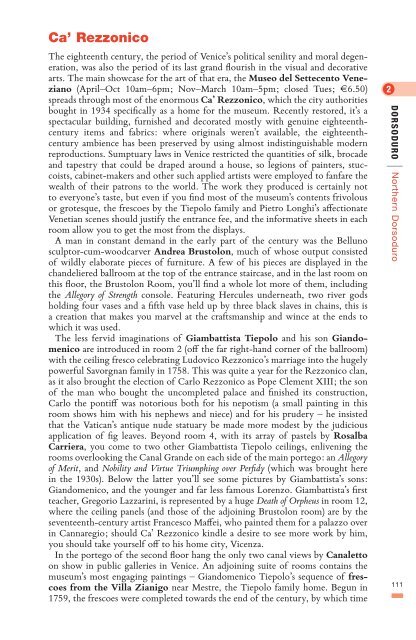You also want an ePaper? Increase the reach of your titles
YUMPU automatically turns print PDFs into web optimized ePapers that Google loves.
Ca’ Rezzonico<br />
<strong>The</strong> eighteenth century, <strong>the</strong> period of <strong>Venice</strong>’s political senility <strong>and</strong> moral degeneration,<br />
was also <strong>the</strong> period of its last gr<strong>and</strong> flourish in <strong>the</strong> visual <strong>and</strong> decorative<br />
arts. <strong>The</strong> main showcase for <strong>the</strong> art of that era, <strong>the</strong> Museo del Settecen<strong>to</strong> Veneziano<br />
(April–Oct 10am–6pm; Nov–March 10am–5pm; closed Tues; e6.50)<br />
spreads through most of <strong>the</strong> enormous Ca’ Rezzonico, which <strong>the</strong> city authorities<br />
bought in 1934 specifically as a home for <strong>the</strong> museum. Recently res<strong>to</strong>red, it’s a<br />
spectacular building, furnished <strong>and</strong> decorated mostly with genuine eighteenthcentury<br />
items <strong>and</strong> fabrics: where originals weren’t available, <strong>the</strong> eighteenthcentury<br />
ambience has been preserved by using almost indistinguishable modern<br />
reproductions. Sumptuary laws in <strong>Venice</strong> restricted <strong>the</strong> quantities of silk, brocade<br />
<strong>and</strong> tapestry that could be draped around a house, so legions of painters, stuccoists,<br />
cabinet-makers <strong>and</strong> o<strong>the</strong>r such applied artists were employed <strong>to</strong> fanfare <strong>the</strong><br />
wealth of <strong>the</strong>ir patrons <strong>to</strong> <strong>the</strong> world. <strong>The</strong> work <strong>the</strong>y produced is certainly not<br />
<strong>to</strong> everyone’s taste, but even if you find most of <strong>the</strong> museum’s contents frivolous<br />
or grotesque, <strong>the</strong> frescoes by <strong>the</strong> Tiepolo family <strong>and</strong> Pietro Longhi’s affectionate<br />
Venetian scenes should justify <strong>the</strong> entrance fee, <strong>and</strong> <strong>the</strong> informative sheets in each<br />
room allow you <strong>to</strong> get <strong>the</strong> most from <strong>the</strong> displays.<br />
A man in constant dem<strong>and</strong> in <strong>the</strong> early part of <strong>the</strong> century was <strong>the</strong> Belluno<br />
sculp<strong>to</strong>r-cum-woodcarver Andrea Brus<strong>to</strong>lon, much of whose output consisted<br />
of wildly elaborate pieces of furniture. A few of his pieces are displayed in <strong>the</strong><br />
ch<strong>and</strong>eliered ballroom at <strong>the</strong> <strong>to</strong>p of <strong>the</strong> entrance staircase, <strong>and</strong> in <strong>the</strong> last room on<br />
this floor, <strong>the</strong> Brus<strong>to</strong>lon Room, you’ll find a whole lot more of <strong>the</strong>m, including<br />
<strong>the</strong> Allegory of Strength console. Featuring Hercules underneath, two river gods<br />
holding four vases <strong>and</strong> a fifth vase held up by three black slaves in chains, this is<br />
a creation that makes you marvel at <strong>the</strong> craftsmanship <strong>and</strong> wince at <strong>the</strong> ends <strong>to</strong><br />
which it was used.<br />
<strong>The</strong> less fervid imaginations of Giambattista Tiepolo <strong>and</strong> his son Gi<strong>and</strong>omenico<br />
are introduced in room 2 (off <strong>the</strong> far right-h<strong>and</strong> corner of <strong>the</strong> ballroom)<br />
with <strong>the</strong> ceiling fresco celebrating Ludovico Rezzonico’s marriage in<strong>to</strong> <strong>the</strong> hugely<br />
powerful Savorgnan family in 1758. This was quite a year for <strong>the</strong> Rezzonico clan,<br />
as it also brought <strong>the</strong> election of Carlo Rezzonico as Pope Clement XIII; <strong>the</strong> son<br />
of <strong>the</strong> man who bought <strong>the</strong> uncompleted palace <strong>and</strong> finished its construction,<br />
Carlo <strong>the</strong> pontiff was no<strong>to</strong>rious both for his nepotism (a small painting in this<br />
room shows him with his nephews <strong>and</strong> niece) <strong>and</strong> for his prudery – he insisted<br />
that <strong>the</strong> Vatican’s antique nude statuary be made more modest by <strong>the</strong> judicious<br />
application of fig leaves. Beyond room 4, with its array of pastels by Rosalba<br />
Carriera, you come <strong>to</strong> two o<strong>the</strong>r Giambattista Tiepolo ceilings, enlivening <strong>the</strong><br />
rooms overlooking <strong>the</strong> Canal Gr<strong>and</strong>e on each side of <strong>the</strong> main portego: an Allegory<br />
of Merit, <strong>and</strong> Nobility <strong>and</strong> Virtue Triumphing over Perfidy (which was brought here<br />
in <strong>the</strong> 1930s). Below <strong>the</strong> latter you’ll see some pictures by Giambattista’s sons:<br />
Gi<strong>and</strong>omenico, <strong>and</strong> <strong>the</strong> younger <strong>and</strong> far less famous Lorenzo. Giambattista’s first<br />
teacher, Gregorio Lazzarini, is represented by a huge Death of Orpheus in room 12,<br />
where <strong>the</strong> ceiling panels (<strong>and</strong> those of <strong>the</strong> adjoining Brus<strong>to</strong>lon room) are by <strong>the</strong><br />
seventeenth-century artist Francesco Maffei, who painted <strong>the</strong>m for a palazzo over<br />
in Cannaregio; should Ca’ Rezzonico kindle a desire <strong>to</strong> see more work by him,<br />
you should take yourself off <strong>to</strong> his home city, Vicenza.<br />
In <strong>the</strong> portego of <strong>the</strong> second floor hang <strong>the</strong> only two canal views by Canalet<strong>to</strong><br />
on show in public galleries in <strong>Venice</strong>. An adjoining suite of rooms contains <strong>the</strong><br />
museum’s most engaging paintings – Gi<strong>and</strong>omenico Tiepolo’s sequence of frescoes<br />
from <strong>the</strong> Villa Zianigo near Mestre, <strong>the</strong> Tiepolo family home. Begun in<br />
1759, <strong>the</strong> frescoes were completed <strong>to</strong>wards <strong>the</strong> end of <strong>the</strong> century, by which time<br />
dorsoduro Nor<strong>the</strong>rn Dorsoduro<br />
|<br />
111







